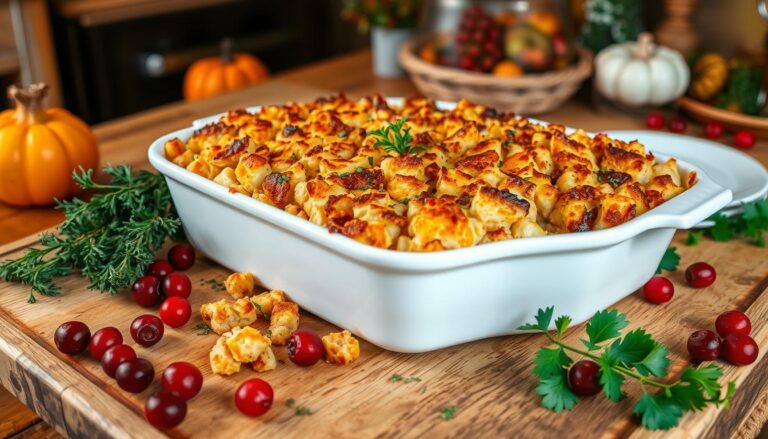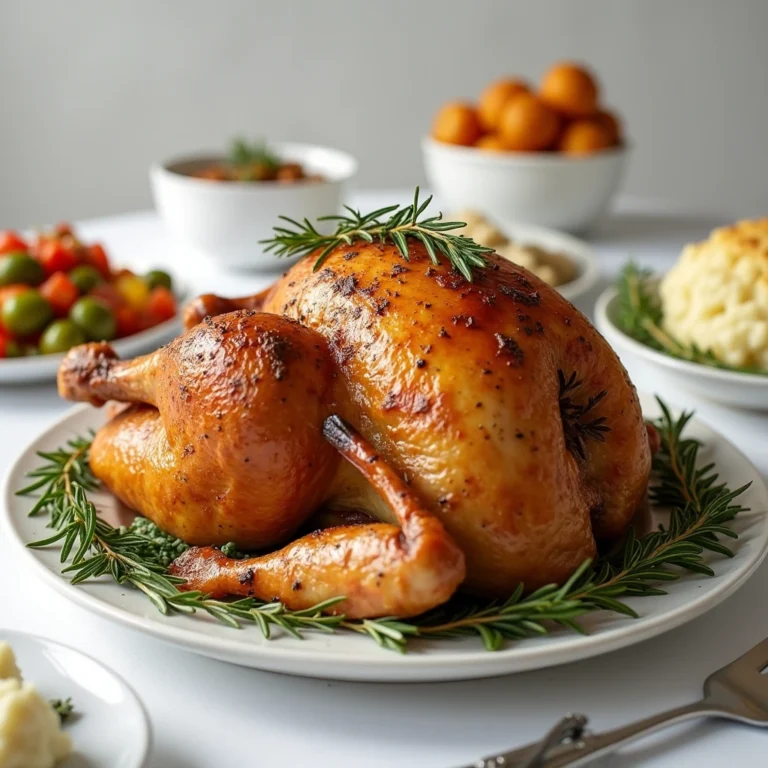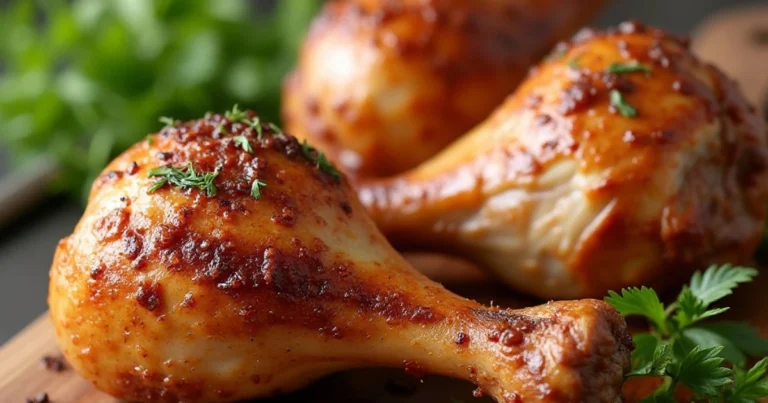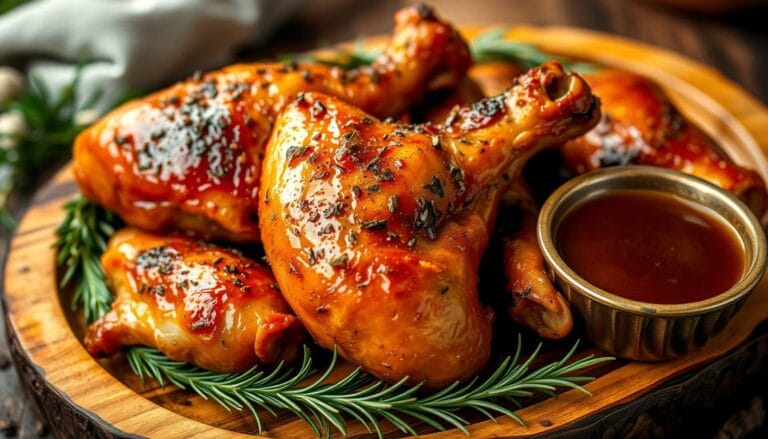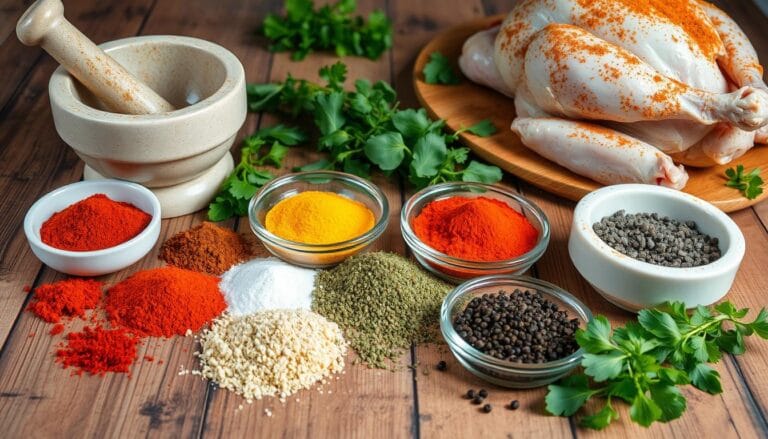How to Cook Turkey Necks on the Stove: Southern Recipe Guide
Table of Contents
As autumn arrives, the smell of turkey necks cooking on the stove brings back memories of my grandmother’s kitchen. The scent of the meat fills the house, signaling a cozy meal is coming. In the South, turkey necks were a favorite, and learning to cook them perfectly is a cherished skill.
In this guide, we’ll explore how to cook turkey necks on the stovetop. You’ll learn how to make them tender and delicious in your kitchen. We’ll cover cleaning, preparation, and the right simmering time to make these cuts a Southern treat.
Understanding Turkey Necks: A Southern Delicacy
Turkey necks are a key part of Southern cooking. They bring a rich flavor that comes from African American traditions. These cuts are not only affordable but also make meals warm and satisfying.
Nutritional Benefits
Turkey necks may look simple, but they are packed with nutrients. A 4-ounce serving has 398 calories and 18g of fat. They also have 348mg of cholesterol and 726mg of sodium. Plus, they offer 50g of protein.
They are also full of vitamins and minerals. You get 105% of Vitamin A, 87mg of calcium, and 3.2mg of iron. This makes them a great choice for healthy meals.
Why Choose poultry necks for Cooking
The meat of turkey necks is soft and velvety. This is because they have a lot of collagen. When cooked, this collagen makes the meat tender and rich.
The dark meat of turkey necks adds a deep flavor to many dishes. They are perfect for Southern comfort food and soul food recipes. You can use them in stews, soups, or braised dishes.
Turkey necks are easy to cook and won’t break the bank. They make simple meals into Southern delicacies. Their unique taste and health benefits make them a favorite in the South.
Essential Ingredients and Equipment for Stovetop
Cooking turkey necks on the stovetop needs a few key things. You’ll need turkey necks, beef or turkey broth, and veggies like onions, celery, and carrots. Don’t forget bay leaves, garlic, salt, and pepper for flavor.
You’ll also need a big pot or Dutch oven with a tight lid. This helps the turkey necks cook evenly. A colander or fine-mesh sieve is great for straining the broth. And, a sharp knife is essential for cleaning the turkey necks.
For a full meal, you might add smoked sausage, potatoes, or corn. The right tools and ingredients make sure your turkey necks are tender and full of flavor.
| Turkey Neck Ingredients | Essential Cooking Equipment |
|---|---|
|
|
With the right ingredients and tools, you’re set to make a tasty stovetop turkey neck dish. Your taste buds will thank you.
Proper Cleaning and Preparation Techniques
Cleaning turkey necks right is key for safety and taste. First, cut off any extra fat and skin with a sharp knife. Then, rinse the necks well under cold water. Next, scrub them with lemon or white vinegar to get rid of dirt and bad smells.
Removing Excess Fat and Skin
Use a sharp knife to remove big pieces of fat or extra skin from the turkey necks. This makes the final product leaner and prevents it from getting too greasy while cooking.
Cleaning Methods with Lemon or Vinegar
- Rinse the trimmed turkey necks under cold running water, ensuring all surfaces are thoroughly cleaned.
- In a large bowl, prepare a solution of warm water mixed with the juice of one lemon or a few tablespoons of white vinegar.
- Submerge the turkey necks in the lemon or vinegar solution and let them soak for 10-15 minutes. This helps to remove any lingering blood or impurities.
- Rinse the necks again under cold water to remove any residue from the cleaning solution.
- Pat the turkey necks dry with paper towels before seasoning and cooking.
Proper cleaning and prep of turkey necks make for a tasty, safe dish. Take the time to remove extra fat and use lemon or vinegar for the best start to your stovetop turkey neck dish.
How Long to Cook savory turkey recipes
Cooking turkey necks on the stovetop requires the right time for the best taste and texture. It usually takes 2 to 3 hours for the meat to become tender and easy to pull off the bone.
First, heat the liquid, like chicken broth or water, until it boils. Then, lower the heat to keep it simmering gently. Let the turkey necks cook for at least 2 hours. You can check if they’re tender after 1.5 hours. Some recipes even suggest cooking them for up to 4 hours for extra tenderness.
The turkey necks are done when the meat comes off the bones easily and is very tender. This slow cooking breaks down the tough parts, making the meat soft and delicious.
By cooking the turkey necks for the right amount of time, you get meat that’s not only tasty but also falls off the bone. This makes them perfect for stews, soups, or any savory dish.
“The key to perfectly cooked turkey necks is patience and a low, slow simmer on the stovetop. The long cooking time is essential for achieving that tender, fall-off-the-bone texture we all love.”
Seasoning and Marinating Tips for Flavorful Results
Getting the most flavor out of turkey necks is simple with the right seasoning and marinating. Try classic Creole spices or aromatic herb blends. These can turn your dish into a true delight.
Traditional Spice Combinations
For turkey neck seasoning, use Creole seasoning, paprika, garlic powder, onion powder, thyme, and black pepper. A Cajun-inspired flavor comes from seafood boil seasoning mix. These spices add a rich flavor that complements the turkey necks.
Marinating Time Recommendations
Marinating turkey necks for a few hours or overnight boosts their flavor. The marinating turkey necks process lets the meat absorb the seasonings. This makes the dish more tender and flavorful. Marinating is optional but highly recommended for the best taste.
For a Southern twist, add onions, bell peppers, and celery to your marinade or seasoning. This “holy trinity” adds a deep flavor to the turkey necks.
“Marinating turkey can add extra flavor to the meal, making it a popular choice for enhancing the taste of poultry.”
When using flavor enhancing techniques for turkey necks, don’t be afraid to try new spice blends and marinating times. Find the perfect mix that matches your taste.
The Perfect Stovetop Simmering Method
Making simmered turkey necks tender and flavorful on the stovetop is an art. It turns this simple ingredient into a Southern favorite. The secret is to cook them slowly, letting their rich flavors come out.
Start by browning the turkey necks in a big pot or Dutch oven over medium-high heat. This step seals in the juices and adds depth to the taste. Once they’re golden, take them out and set them aside.
- Sauté onions, celery, and garlic in the same pot. This adds a fragrant base to the dish.
- Make a roux by whisking in flour to thicken the gravy.
- Put the simmered turkey necks back in the pot and add chicken or turkey stock.
- Bring it to a boil, then lower the heat to a simmer.
- Cover the pot and let the slow-cooked turkey necks simmer for 2-3 hours. Stir now and then, adding more liquid if it gets too thick.
The slow simmer turns tough turkey necks into tender, flavorful bites. They soak up the rich flavors of the broth and aromatics. This dish captures the heart of Southern cooking.
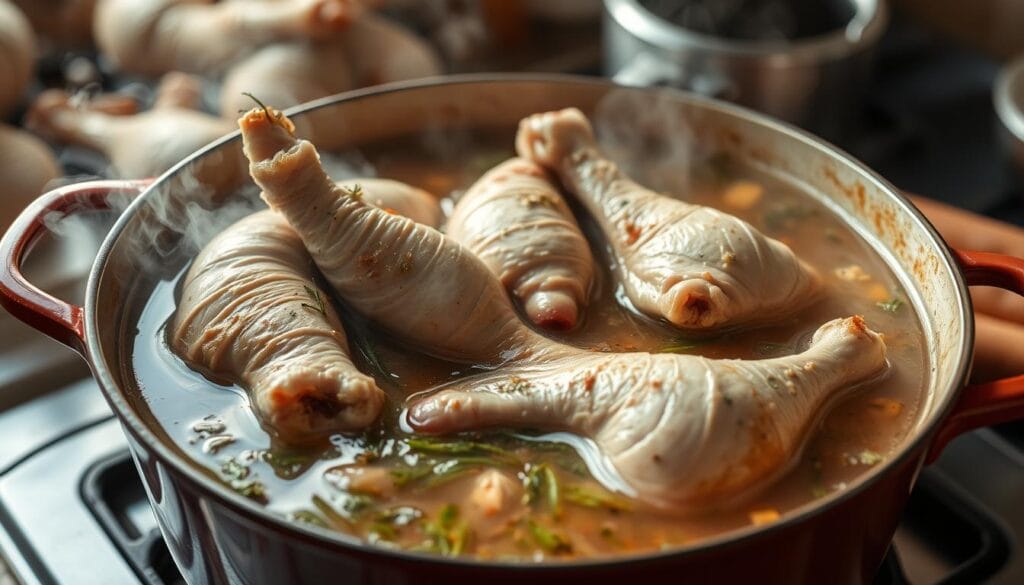
“The true magic of simmered turkey necks lies in the patience and care you put into the process. With time and attention, these humble ingredients transform into a dish that nourishes the body and warms the soul.”
Creating Rich Gravy from this Southern delicacy
Make your holiday feast special with homemade turkey neck gravy. It’s full of flavor. Making great gravy is an art. With the right steps, you can create a delicious, velvety gravy that will wow your guests.
Straining and Storing the Broth
After simmering the turkey necks, it’s time to strain the broth. Pour it through a fine-mesh sieve, getting rid of solids and veggies. This makes your gravy smooth. You can store the broth in the fridge for up to 4 days or freeze it for later.
Gravy Making Techniques
To make the perfect turkey neck gravy, start with a roux. Melt butter or turkey fat in a saucepan. Then, whisk in an equal amount of flour. Cook the roux until it’s light golden, stirring constantly.
Slowly add the strained turkey neck broth, whisking to avoid lumps. Simmer until it’s the right thickness. Season with salt, pepper, and herbs or spices to taste.
| Ingredient | Quantity |
|---|---|
| Turkey Neck Broth | 4 cups |
| Butter or Turkey Fat | 1/4 cup |
| All-Purpose Flour | 1/4 cup |
| Salt and Pepper | To Taste |
| Fresh Herbs (optional) | 1-2 tbsp, chopped |
For a smooth gravy, whisk patiently and adjust the flour and liquid as needed. Try adding sherry, maple syrup, or Worcestershire sauce for a unique flavor.
“The secret to the best turkey neck gravy is in the patience and attention to detail during the cooking process. The result is a rich, velvety sauce that will have your guests raving.”
Signs of Properly Cooked savory
Cooking turkey necks right is all about getting them tender. You’ll know they’re done when you see certain signs.
The meat should be easy to pull apart with a fork. It should also reach an internal temperature of at least 165°F (74°C). This ensures they’re safe to eat and taste great.
- Turkey necks should be fork-tender, with meat easily separating from the bones.
- The internal temperature should reach at least 165°F (74°C) for food safety.
- The meat should be moist and flavorful, having absorbed the cooking liquid and seasonings.
If the turkey necks are still tough after 2 hours, keep cooking. Check them every 30 minutes until they’re tender. Being patient and careful is crucial for turkey neck doneness.
| Cooking Indicator | Desired Result |
|---|---|
| Texture | Fork-tender, meat easily pulls away from bones |
| Internal Temperature | Minimum of 165°F (74°C) |
| Moisture and Flavor | Moist and infused with cooking liquid and seasonings |
“The secret to perfectly cooked turkey necks is patience and attention to detail. By monitoring the doneness and adjusting the cooking time as needed, you’ll be rewarded with tender turkey necks that melt in your mouth.”
Serving Suggestions and Side Dishes
There are many ways to serve delicious turkey necks. They go well with classic Southern sides that match their rich flavors. Try serving them over fluffy white rice. This lets the broth soak in, making the meal even more enjoyable.
For a true soul food experience, pair turkey necks with sides like creamy mashed potatoes and buttery cornbread. Sautéed collard greens are a great match too. They soak up the savory flavors of the turkey necks, making a perfect dish. Collard greens are often cooked with smoked turkey to add more flavor.
Roasted sweet potatoes or candied yams are also great options. They add a sweet contrast to the savory meat. For a heartier meal, add sliced smoked sausage or kielbasa to the pot. This turns the dish into a Cajun-inspired turkey neck and sausage boil.
| Suggested Side Dishes | Pairing Notes |
|---|---|
| Cornbread | The dense, slightly sweet cornbread complements the rich, savory turkey necks perfectly. |
| Collard Greens | The turkey necks lend their smoky, meaty flavor to the collard greens, creating a classic Southern pairing. |
| Mashed Potatoes | Creamy mashed potatoes soak up the flavorful turkey neck broth, making for a comforting and satisfying meal. |
| Candied Yams | The sweetness of candied yams balances the savory turkey necks, creating a harmonious flavor profile. |
Choose any sides you like, but let the turkey necks be the main attraction. The right sides will enhance their bold, soulful taste.
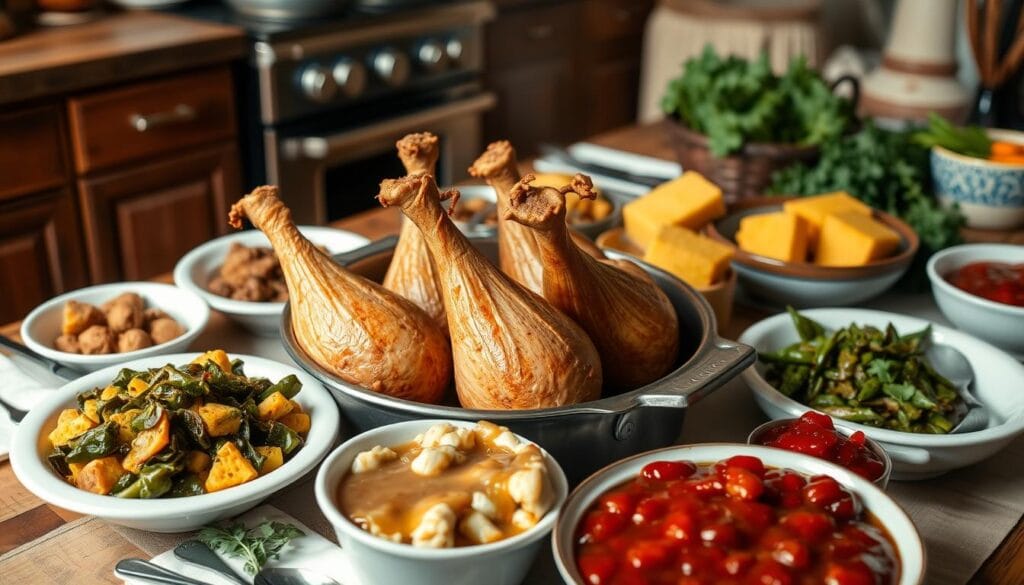
Storage and Reheating Guidelines
Keeping your turkey necks fresh and tasty is key. Follow these tips to enjoy your leftovers.
Proper Storage Methods
Store cooked turkey necks in an airtight container in the fridge for up to 3 days. For longer storage, freeze them for up to 3 months. Thaw in the fridge before reheating.
Best Reheating Practices
Ready to enjoy your leftover turkey necks? Here are some great ways to reheat them:
- Oven Reheating: Put the turkey necks in a covered dish with broth or gravy. Warm in a 300°F (150°C) oven for 12-15 minutes per pound.
- Stovetop Reheating: Reheat the turkey necks on low heat, adding liquid to keep them moist.
- Microwave Reheating: Heat the turkey necks in the microwave on low, stirring often, until they reach 165°F (74°C).
Choose your method, but make sure to reheat the turkey necks well. This ensures they’re safe and delicious.
“Proper storage and reheating of cooked turkey necks is key to enjoying their rich, savory flavor long after the initial meal.”
Common Cooking Mistakes to Avoid
Cooking turkey necks on the stovetop can be tricky. It’s important to avoid common mistakes that can ruin your dish. Let’s look at some common turkey neck cooking errors and how to fix them for delicious results.
One big mistake is not cleaning the turkey necks well. If you don’t remove excess fat and skin, your dish will be greasy. Make sure to clean them with lemon or vinegar to get rid of impurities.
Another mistake is cooking the necks too long or too short. Overcooking makes them dry and tough, while undercooking makes them chewy. It’s important to cook them just right, following the recommended times.
Using too much liquid is another common error. While some liquid is needed, too much can water down the flavors. Be careful not to add too much.
Finally, don’t rush the cooking or use too high heat. This can prevent the meat from becoming tender and flavorful. Cooking slowly and gently is key to getting the best out of your Southern delicacy.
By avoiding these mistakes, you can become a pro at cooking turkey necks on the stovetop. With the right techniques and care, you can turn this simple ingredient into a delicious dish that will impress everyone.
Conclusion
Cooking turkey necks on the stove is a rewarding experience. It honors Southern and soul food traditions. With the right preparation, seasoning, and slow cooking, turkey necks become tender and flavorful.
They are rich in nutrients and carry cultural significance. Whether as a main dish or to enhance others, cooking turkey necks is a valuable skill. It adds depth to any home cook’s repertoire.
The turkey neck recipe summary shows its benefits. It’s packed with protein and adds deep, savory flavors to dishes. By cleaning, seasoning, and slow-simmering the necks, you unlock their full potential.
Embracing the turkey neck cooking process connects you to cherished traditions. It also adds a satisfying and nourishing dish to your culinary repertoire.
As you explore turkey necks and soul food cooking, enjoy the journey. Experiment with flavors and share this delicious heritage with your loved ones. The techniques and aromas will take you to the heart of Southern and African-American culinary traditions.
They will leave you with a deeper appreciation for slow-cooked, flavorful dishes.
FAQ
How long do you cook turkey necks on the stove?
What are the nutritional benefits of turkey necks?
What are the essential ingredients and equipment needed for cooking turkey necks on the stove?
How should you clean and prepare turkey necks before cooking?
What is the proper stovetop simmering method for turkey necks?
How can you create rich gravy from the turkey neck broth?
What are the signs of properly cooked turkey necks?
What are some common mistakes to avoid when cooking turkey necks?
Did you enjoy making our recipe?
There are no reviews yet. Be the first one to write one.

